Home » Sikh Gurus

Sikhism owes its credit to the ten Sikh Gurus who spanned from 1469 to 1708 spread over 239 years. The main aim of these 10 Gurus was to look after moral well being of the people and spread spiritualism. It is during this span of 239 years that the sacred scriptures were laid by the 10 Gurus.
Gurdwara is place where Shri Gurugranth Sahieb Subshodit hain. Tenth Guru Sh Gurugobind Singh decided that after them no Guru will be on gaddi. Sh Gurugranth Sahieb will be Sikhs Guru once for all. From then the Holly book is our Guru.
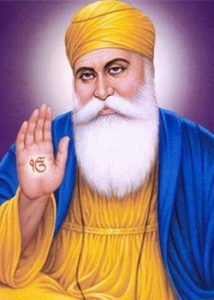
SRI GURU NANAK DEV JI – First Guru
(1469 – 1539)
Sri Guru Nanak Dev ji was the founder of the Sikh religion. He was born in 1469 in a place called Talvandi now called Nankana Sahib which is located in Pakistan. His birthplace is marked by a Gurdwara Janam Asthan. His father was an accountant for the crop revenue in the Nankana sahib.
Sri Guru Nanak Dev ji regarded Hindus and Muslims as equals. He considered himself as neither Hindu or Muslim but as a brother to all those people who believed in God.
His legacy is remembered as:
How was Sikhism born?
Nanak’s sister Bibi Nanaki was one of the persons who recognised divine qualities in the boy. As per the Sikh tradition it is believed that around the year 1499, when Guru Nanak Dev ji was 30 years of age, he had a vision for God. Once it happened that he failed to return from his ablutions, his clothes were found on the bank of a local stream called the Kali Bein. The townspeople assumed he had drowned in the river; Daulat Khan had the river dragged, but no body was found. Three days after disappearing, Nanak reappeared, staying silent. The next day, he pronounced:
“There is neither Hindu nor Mussulman (Muslim) so whose path shall I follow? I shall follow God’s path. God is neither Hindu nor Mussulman and the path which I follow is God’s.”
From this point in history, Guru Nanak Dev ji is described in accounts as a Guru, and Sikhism was born.
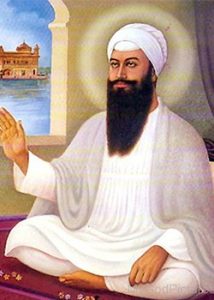
SRI GURU ANGAD DEV JI – Second Guru
(1539 – 1552)
Sri Guru Angad Sahib Ji was born in 1504. He invented and introduced the Gurmukhi (written form of Punjabi) script and made it known to all Sikhs.
He was was born in Sarai Naga, previously named as ‘Matte Di Sarai’, in Muktsar district in Punjab, on Vaisakh Vadi 1st, (5th Vaisakh) Samvat 1561, (31st March 1504).
His father was trader named Bhai Pheru Mall. His mother’s name was Mata Ramo Ji (also known as Mata Sabhirai, Mansa Devi).
The scripture of the Guru Granth Sahib Ji is written in Gurmukhi. This scripture is also the basis of the Punjabi language. He showed the Sikhs the path to self-less service and how to do prayers with great devotion.
He opened many schools for children and believed in increasing the literacy.
He took great interest in the education of the children by opening many schools for their instruction and thus greatly increased literacy.
He started physical as well as spiritual exercises for the youths called as Mall Akhara. He wrote the first biography of Guru Nanak Sahib.
He also wrote 63 Salokas (stanzas), these were included in Guru Granth Sahib. He popularized and expanded the institution of ‘Guru ka Langar’ started by Guru Nanak Sahib earlier.
His legacy is remembered as:
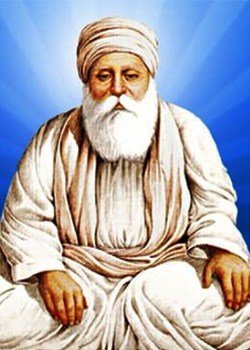
SRI GURU AMAR DAS JI – Third Guru
(1552 – 1574)
Guru Amar Das Ji was born in 1479. He strengthened the concept of Guru Ka Langar (free kitchen) which was originally started by Guru Nanak Ji. He believed that irrespective of their economic status of being rich or poor, high or low in the society all people should sit together and have meals together.
He was against the concept of untouchability and caste prejudices.
He thus established social equality amongst the people. Guru Amar Das introduced the Anand Karaj marriage ceremony for the Sikhs.
The custom of Paradah (Purda), in which a woman was required to cover her face with a veil was also done away with. Guru Amar Das Ji also completely abolished the Sati pratha in which typically a married women forces her to burn alive to die in the funeral pyre of her beloved husband
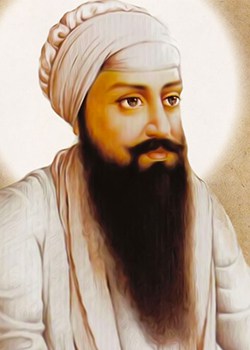
SRI GURU RAM DAS JI – Fourth Guru
(1574 – 1581)
Guru Ram Das Ji was born in 1534. He was the Guru who founded the City of Amritsar where he started the construction of the famous sacred Sarovar at Sri Harmandir Sahib in Amritsar. Amritsar is regarded as the holy city of the Sikhs.
Sikhism believed in One God and has no preference or partiality for any particular race or religion. This is evident by the fact that that Sri Harmandir Sahib remains open on all sides and at all times to everyone.
The standard Sikh marriage ceremony known as the Anand Karaj is centered around the Lavan, a four stanza hymn composed by Guru Ram Das Sahib Ji. Following the tradition of sending out Masands across the country Guru Amar Das Ji deputed Bhai Gurdas to Agra to spread the gospel of Sikhism.
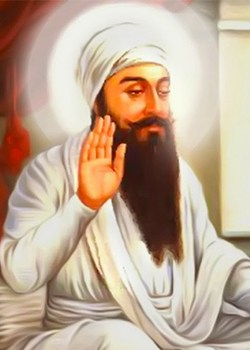
SRI GURU ARJAN DEV JI – Fifth Guru
(1581 – 1606)
Sri Guru Arjan Dev Ji was born in 1563 and he was the third son of Guru Ram Das Ji. He was a saint and scholar of the highest quality and repute. He is famous as he compiled the Adi Granth (the scriptures of the Sikhs) and not only this but he also wrote the Sukhmani Sahib.
Credit goes to Guru Arjan Dev Ji for completing the construction of Sri Darbar Sahib also known as Golden Temple in Amritsar.
Guru Ji became the first great martyr in Sikh history when the alcoholic Muslim Emperor Jahangir ordered his execution on the advice of Chandu Shah, a governor of Lahore.
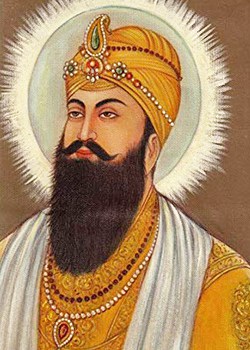
SRI GURU HARGOBIND DEV JI – Sixth Guru
(1606 – 1644)
Sri Guru Hargobind Dev Ji was born in 1595 and was the son of Guru Arjan Sahib and was known as a “soldier saint”. He created and organised a small army, explaining that extreme non-violence and pacifism would only encourage evil and so the principles of Miri-Piri were established.
Guru Ji taught that it was necessary to take up the sword in order to protect the weak and the oppressed. Guru Ji was first of the Gurus to take up arms to defend the faith. At that time it was only emperors who were allowed to sit on a raised platform, called a takhat or throne.
At the age of 13, Guru Hargobind erected Sri Akal Takhat Sahib, ten feet above the ground and adorned two swords, Miri and Piri, representing temporal and spiritual power.

SRI GURU HAR RAI DEV JI – Seventh Guru
(1644 – 1661)
Sri Guru Har Rai Sahib Ji was born in 1630. He was born in Kiratpur, India. He is known as the “tender-hearted” Guru.
He was a man of peache and spent most of his life in devotional meditation and preaching the teachings of Guru Nanak, but he never disbanded the armed Sikh Warriors (Saint Soldiers), who earlier were maintained by his grandfather, Guru Hargobind.
Though he directly never indulged in the any politics or army controversy with the Mughal Empire but, he always boosted the military spirit of the Sikhs, but he never himself indulged in any direct political and armed controversy with the Mughal Empire like Emperor Aurangzeb and devoted his efforts to missionary work. He tried to avoid conflicts with Emperor Aurangzeb.
Guru Har Rai was an amazing herbalist and healer. He was famous for his use of natural medicine, and kept a beautiful herbal garden from which he made his remedies.

SRI GURU HAR KRISHAN DEV JI – Eighth Guru
(1661 – 1664)
Sri Guru Harkrishan Dev Ji was the youngest Guru. He was born in 1656. He was installed as Guru at the age of five and sadly breathed his last at the age of 8 in New Delhi, India, where the Gurdwara of Bangala Sahib has been established.
Guru Har Krishan Dev Ji astonished the Brahmin Pundits with his knowledge and spiritual powers. There was an epidemic of smallpox in Delhi. Guru Har Krishan went to the place where the outbreak had occurred and through his blessing, a spring of sacred water appeared that could heal the people of the illness. He took on the suffering and sickness of the area, taking on smallpox himself – giving his life to help save the lives of others.
Anyone who invokes Guru Har Krishan with a pure heart has no difficulties whatsoever in their life.

SRI GURU TEGH BAHADUR DEV JI – Ninth Guru
(1665 – 1675)
Sri Guru Tegh Bahadur Sahib Ji was born in 1621 in Amritsar and established the town of Anandpur. He was the youngest son of Guru Hargobind.
He was the grandson of Guru Arjan Dev and his son was Gobind Rai who later became Guru Gobind Singh.
The Guru laid down his life for the protection of the hindu religion, their Tilak (devotional forehead markings) and their sacred (janeau) thread.
Guru Teg Bahadur, along with three of his Sikhs – Bhai Matti Das, Bhai Sati Das and Bhai Dayala, willingly allowed themselves to be locked in Aurangzeb’s prison and subjected to truly horrific torture. The three Sikhs died. Guru Teg Bahadur’s torture, however, continued. The Emperor would ask the Guru for some sign that he was a holy many – some miracle. But Guru Teg Bahadur refused to perform any miracles and refused to convert.
Before agreeing to go to prison, Guru Teg Bahadur had written a note to the Emperor to be delivered to the Emperor after the Guru’s death. When the note was read after his death it simply read: “This, then, is the greatest miracle. That I gave my head, but not my faith.”
So pathetic was the torture of Guru Tegh Bahadur that his body had to be cremated clandestinely (a follower burned down his own home to cremate the Guru’s body) at Delhi while his severed head was secretly taken four hundred kilometers away to Anandpur Sahib for cremation. Because of his refusal to convert to Islam a threatened forced conversion of the hindus of Kashmir was also thwarted.
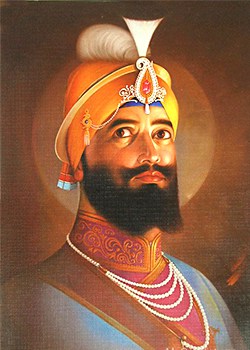
SRI GURU GOBIND DEV JI – Tenth Guru
(1675 – 1708)
Guru Gobind Rai, is the tenth Sikh Guru who later became to be known as Sri Guru Gobind Singh Dev Ji. He was born in Patna, Bihar in India. He had 4 sons. Eldest son was Ajit Singh, followed by Jujhar Singh, Zorawar Singh and Fateh Singh.
Guru Gobind Dev ji was only 9 years old when his father died due to torture and confinement due to Emperor Aurangzeb.
Guru Gobind Rai through the guidance of the Creator gave the Sikhs Amrit. Guru Gobind Rai took Amrit from the hands of his own Sikhs and was reborn as Guru Gobind Singh. The Order of the Khalsa was established – a group of men and women dedicated to living in equality and peace, but willing to fight and lay down their lives to protect themselves and others from injustice and tyranny.
Sadly, Guru Gobind Singh’s two eldest sons died in the fight with Aurangzeb and the two younger sons were captured by a Governor in league with Aurangzeb. He was was the creation of the Siri Guru Granth Sahib.At the end of his life, in 1708, Guru Gobind Singh passed the mantle of the Guruship to the Siri Guru Granth Sahib. This ended the time of the physical Gurus of the Sikhs. Thereafter began the reign of the Shabad Guru, itself, as the Spiritual Light and Guide for the Sikh community. The younger sons were bricked alive inside a wall and died.Read more
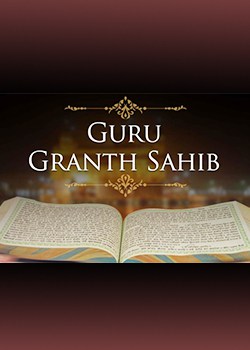
SRI GURU GRANTH SAHIB – “The Eleventh Guru”
(1708 – Eternity)
The Guru Granth Sahib was first compiled as Adi Granth by the Fifth Sikh Guru, Arjan Dev, in 1604 in the city of Amritsar. Later on, Guru Gobind Singh, (the tenth Guru) added one shloka, dohra mahala 9 ang, 1429 and all 115 hymns of his father, Guru Tegh Bahadur ji (the ninth Guru). It is considered the Supreme Spiritual Authority and Head of the Sikh religion, rather than any living person.
This second rendition came to be known as Sri Guru Granth Sahib. After Guru Gobind Ji death in 1708, many copies of the granth were prepared for distribution by Baba Deep Singh and Bhai Mani Singh.
Guru Granth Sahib is a collection of devotional hymns and poetry which proclaims God, lays stress on meditation on the True Guru (God), and lays down moral and ethical rules for development of the soul, spiritual salvation and unity with God. It contains 1430 pages and contains the actual words spoken by the founders of the Sikh religion (the Ten Gurus of Sikhism).
Before passing away, Guru Gobind Singh Ji (1708) decreed that the Sikhs were to regard the Granth Sahib as their next and everlasting Guru. He said – “Sab Sikhan ko hokam hai Guru Manyo Granth” meaning “All Sikhs are commanded to take the Granth as Guru”. Hence since then Guru Granth Sahib Ji is regarded as the 11th eternal Guru.
Within it’s 1430 pages, the shabads (hymns) of the Sri Guru Granth Sahib are arranged in thirty-one called as Ragas, the traditional Indian musical measures and scales. Within the Ragas, they are arranged by order of the Sikh Gurus, with the shabads of the Hindu and Muslim Saints following.
Begining of the Guru Granth Sahib starts off with the word “Ek Onkar”. This means – Word to the tenth Word “Gur-parshad” is called the Mool Mantra. Rest of the composition after this is called the Japji which was composed by Sri Guru Nanak Dev. This consists of 38 Pauris or stanzas, a Prologue and an Epilogue. It is also the morning prayer of the Sikhs.
The next composition has two parts – (A) “So Dar” and (B) “So Purkh”. The Bani, “So Dar” contains 5 Shabads and “So Purkh” contains 4 Shabads. This comprises the most of the evening prayer of the Sikhs and is called the Rehras. After this is the Bani called Sohila which contains 5 Shabads and is the bed-time prayer.
It gives us great pleasure to announce the reopening of GURU NANAK SAR GURDWARA PORTSMOUTH This coming Sunday 08 October 2023.
All Guru jis Shardallu are humbly requested to attend.
A full programme with Recitation of Siri Sukhmani Sahib will commence at 10.30 am. A full Kirtan programme will be hosted (Raghbir Singh Rahi)
Guru ka Langar will be served..